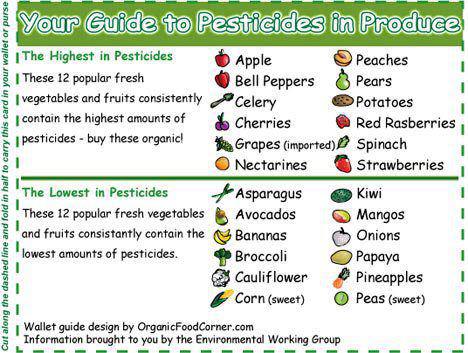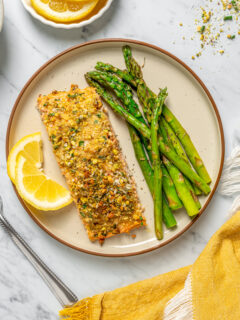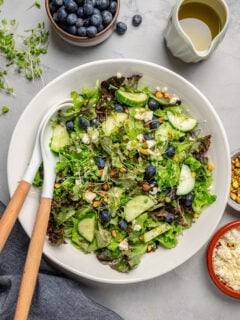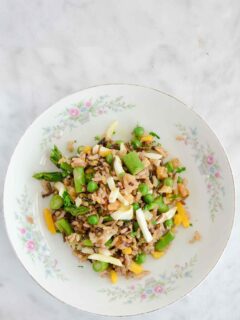I really thought that by this time, I would have some seeds started in the garden. Last March I already had romaine and spinach along with radishes peeking out of the soil. This year, I just want the ground to thaw. As I am writing this post it is snowing furiously and the high temperature will end up being 39. I think its safe to say Phil the groundhog needs to find a new job!
So with Mother Nature keeping me inside and not allowing me to share with you my gardening tips I thought I would share a comment one of my followers, Ron in Sunny Florida wrote regarding my post from last week “What are GMO’s”
Hello Amy, Thank you for your dedication to informing the public.
As much as I support and understand the importance for requiring food companies to label food products that have GMO’s, I find it more important to organize our voice in demanding that The United States band the practice all together…As you already have pointed out the practice of splicing DNA so that crops can stand up to stronger chemicals and harsher growing conditions is dangerous to all of life.
Also after reading the never-ending list of foods that are Genetically Modified, it is a parent that labeling them will lead to a trend in Non-GMO foods causing the price of non-GMO food products to skyrocket; much like the price of organic food compared to non-organic food.
I’m not sure how it is where you live but the price of Organic Tomatoes here in Fl. averages around 3.99/lb compared to 1.79per pound for non-organic tomatoes. And that is across the board when you compare Organic food to non-organic food.
And as much as I am health conscious…I can’t afford a weekly grocery bill that is double what I already spend.
Healthy wholesome food should not be trendy and only for the wealthy.
Ron is correct, buying organically is extremely expensive and if you are on a fixed budget how can you feed yourself and your family the safest foods if the foods you want to buy are double or triple the same food that is labeled GMO or is not organic. Ironically a few days after my post went up last week, Whole Foods announced that they would start labeling GMO foods in their stores. I personally love whole foods, especially their meats and seafood department, but it can be down right painful to pay the prices that they ask. So, how can we eat the healthiest safest foods without feeling like we need to take out a loan to eat dinner without ingesting pesticides and toxins that can be on our foods?
Here is my mantra..
- Grow your own produce. Grow what you already eat. For example we eat a lot of tomatoes in this family and tomatoes are relatively easy to grow and can be grown in small spaces (pots, hanging planters). You can also can tomatoes several different ways, marinara, salsa, crushed, whole, etc.. Canned tomatoes can be pulled out over the winter for chili, soups, sauces, etc. Along with canning your vegetables consider canning fruits, there is nothing better than making and eating your own jams. Check out a recent post on TheKitchn from author Karen Solomon about her book Jam It, Pickle It, Cure it about the best way to eat locally and preserve the bounty.
2. Freeze fresh produce and herbs. Freezing is simple and most vegetables and herbs can be frozen. If you don’t have space for mass amount of freezing, again you can process your produce and can. Mason jars can be recycled and stacked for saving space.
3. Shop at your local farmers markets. I will admit I don’t really have a need to shop farmers markets because I am usually looking to give produce away during the summer, but I still like spending a Sunday morning after breakfast walking around the local famers market visiting and checking out what the locals are selling. Their produce is fresher and the prices are better than the grocery store. (remember to ask if they grow organic, just because they are at a farmers market doesn’t mean they do.)
4. If you don’t have room to grow your own garden, how about joining a gardening co-op, they seem to be popping up all over. You can rent a plot or you can just pay a fee and pick up the produce available at a local garden once a week. Plus as a family what a great way to teach your children about where their food comes from and spend time together.
5. Think frozen, the frozen section in the organic section of our local grocery store is growing. This isn’t the best, I really believe that fresh is best, but frozen organic fruits and vegetables (with no added ingredients) is a close second to fresh produce.
Lastly buy smart organically. Here is a list of the 12 most important produce to buy organically:
- Nectarines – 97.3% of nectarines sampled were found to contain pesticides.
- Celery – 94.5% of celery sampled were found to contain pesticides.
- Pears – 94.4% of pears sampled were found to contain pesticides.
- Peaches – 93.7% of peaches sampled were found to contain pesticides.
- Apples – 91% of apples sampled were found to contain pesticides.
- Cherries – 91% of cherries sampled were found to contain pesticides.
- Strawberries – 90% of strawberries sampled were found to contain pesticides.
- Imported Grapes – 86% of imported grapes (i.e. Chile) sampled were found to contain pesticides.
- Spinach – 83.4% of spinach sampled were found to contain pesticides.
- Potatoes – 79.3% of potatoes sampled were found to contain pesticides.
- Bell Peppers – 68% of bell peppers sampled were found to contain pesticides.
- Red Raspberries – 59% of red raspberries sampled were found to contain pesticides.
Ron, I hope my list helps. I think it is important for everyone to be able to eat not only eat fresh produce but pesticide free. If you guys have any tips that you have found to buying or growing organic, please share them. We all can help each other by sharing our knowledge!!
xo Amy
P.S – SPRING GET YOUR BUTT OVER TO MY HOUSE, PHIL SAYS YOUR LATE!













It is wonderful to hear that the frozen organic section in your local grocery store is expanding. Why do you think this is? How do you think we can make the fresh (non-frozen) organic section in grocery stores to expand?
This was a wonderful article to read regarding the high cost of organic food. What do you think we can do to help organic food become more attainable? I purchase organic food when available but would like to help innovate this industry and help America become a predominantly organic nation.
I am also pro organic food because they are healthier and even tastier than the conventional or GMOs. They are free of insecticides or any herbicides that may pose risks to health as it has been known to cause certain abnormalities and for its immunosuppresive properties. Thanks a lot for sharing your thoughts on this matter. We share the same ideas basically.
Its a pleasure to have you here Louise. Eating healthy is the basis of living a healthy life, it is so important. Thanks for sharing your ideas.
Goodmorning Amy,
First I want to say you are a very talented write…quite a gift.
Thank you for taking the time to address the issue regarding the high cost of shopping for organic food. You really covered all the bases. And you went the extra mile with your list of food that is found to be high in pesticides. Here in my town – once a mecca of farms – Farmers Markets use to be a way of life for everyone, that is until tourism trumped the agricutural industry and developers begain buying up huge plots of land that served as a source for locally grown food. Instead of growing Tomatos, Peppers, Oranges, Broccolii, Cellery, Lettuce, etc. they built malls, shopping plazas, and sud divided communities with “ticky tacky looks all the same houses”, country clubs and golf courses for elitist. Her in my town we have 28 18 hole Championship Golf Course; some have 36 holes. Just one of those courses alone would be sizable enough to grow enough veggies to supply our town. And might I add 98% of these gated communities have non native landscapes that require thousands of gallons of water, agressive fertilizers, and constant spraying of pesticides in order to thrive. All of this is not sustanable to a healthy and happy life. But I digress.
We are starting to see small local farms making a come back. For those willing to get involved; it’s more a personal plight, a way of life, a labor of love, focused on producing healthy food than just high yields and bottom line profit; though making some bank is the only way to survive and thrive.
One farm in particular, Honey Sweet, is a U-Pick farm, and they are very popular during Strawberry season as they DO NOT use harmful chemical sprays and agressive fertilizers.
So the word is getting out there, but ALL of us who are Conscientious Objectors when it comes to the use of GMO’s to produce our food MUST continue our plight in getting back to natural nonGMO organic foods.
That the company Whole Foods Market is taking action to lable the GMO foods they carry IS a step in supporting Consumer Rights…But fully commited direction towards stopping the production of foods made from GMOs would be for them to stop carrying those products; which in turn would send a very clear messege to the companies that produce and distribute foods with GMOs. A messege like that would encourage other food companies to get on board and would quickly change the food industry.
I just hope it dosen’t take decades in order to do so…But that is up to We the Consumer. Every company’s main concern is bottom line profit…So ya gotta hit ’em where it counts!
Again thank you Amy for your time and concern for clean and healthy food.
Your friend in the garden,
Ron In Sunny Florida